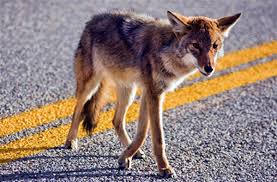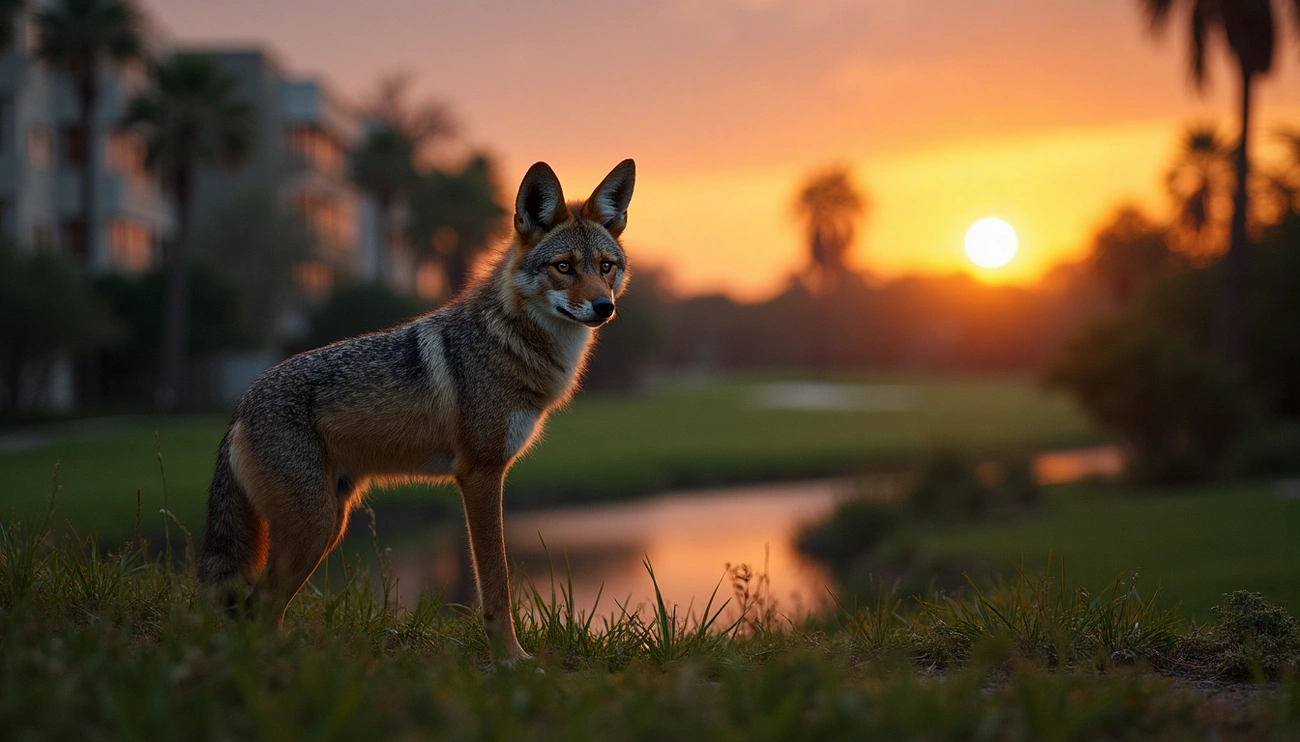Coyote Sightings in Hidden Valley: What Boca Raton Residents Need to Know
Table of contents
- Alert: Multiple Coyote Sightings Spark Concern in Boca Raton
Alert: Multiple Coyote Sightings Spark Concern in Boca Raton

They’re not just desert legends anymore. In Hidden Valley, coyotes have become early morning regulars and they’re not here for brunch.
Coyote sightings have increased in Boca Raton these past years, raising major concerns among local residents. Homeowners across the city have reported these wild canines. Many have shared photos and videos of coyotes that roam through suburban streets, parks, and backyards.
The coyote population in Boca Raton, Florida has reached record levels. Hidden Valley’s residents now spot these animals almost daily, especially during early morning and evening hours. Communities close to parks and waterways see these wild animals more often. This surge raises questions about human-wildlife interactions as our region continues to develop.
Our community members worry about these wild predators, especially when they have pets and small children nearby. Wildlife officials stress that coyotes rarely threaten humans directly. In this piece, we’ll look at why coyotes appear more frequently in our city and how they moved across Florida. We’ll also explore their ecological role and share ways to safely coexist with these adaptable animals.
Why Are Coyotes Appearing More Frequently in Boca Raton?
Boca Raton has seen a recent surge in coyote sightings due to several connected factors that have changed how humans and wildlife interact in our area. People now see these animals regularly instead of the occasional encounters of the past, as urban growth continues to change the natural environment.
Land development displaces wildlife
Coyotes now move into residential areas because construction and land clearing in Boca Raton have pushed them from their homes. Major infrastructure projects in progress include:
- Lake Worth Drainage District and South Florida Water Management District canal clearing operations
- Florida Department of Transportation’s express lane project affecting the Hillsboro Canal area
- Hillsboro El Rio Park development off 18th Street
- Palm Beach County’s shared use pathway along Palmetto Park Road
- on the former Ocean Breeze Golf CourseGreater Boca Raton Beach and Park District’s construction
These projects disrupt coyote habitats throughout the city. “One reason for more frequent glimpses of coyotes in some areas is the land clearing for big projects, which is exposing and displacing wildlife,” local reports state.
Ecologists call these human-altered areas with some wild vegetation “disturbed habitat.” These spaces provide resources and shelter for wildlife that can adapt, even though they might seem unwelcoming.
Canals and parks create natural corridors
Coyotes use waterways and green spaces as key routes through urban areas. Research shows these animals use infrastructure like roads, railways, and flood channels as movement paths rather than obstacles.
South Florida’s extensive canal system creates perfect travel routes for coyotes. The Lake Worth Drainage District and South Florida Water Management District’s major canal clearing projects pushed out coyotes that had made their homes along these waterways.
Studies show that but will use disturbed areas where humans rarely go – like railroads, utility corridors, and empty land. Boca Raton’s connected system of parks, drainage ditches, and undeveloped land creates a network for coyotes to move throughout the city.urban coyotes prefer natural habitat patches
Coyote Hidden Valley sightings linked to nearby construction
Hidden Valley’s residents report troubling encounters with coyotes. “The coyotes for whatever reason are running rampant,” said Kim Russo, a Hidden Valley resident. These sightings directly link to nearby development projects.
Mary McGuire, a Boca Raton spokesperson, reports coyote sightings in Palm Beach Farms, Camino Gardens, and Boca Square neighborhoods. These areas’ proximity to construction zones explains the high number of sightings.
This isn’t new. A similar spike in coyote concerns happened during the I-95/Spanish River interchange construction a few years ago. Wildlife displacement naturally follows as we develop previously wild areas.
Coyotes show remarkable ability to adapt to human-dominated areas. Wildlife experts say, “These animals have adapted to urban environments and they’re here because we as humans have made it accessible to them”. Coyote sightings will likely remain common in Boca Raton’s future because of their adaptability and ongoing development.
How Coyotes Spread Across Florida Over Time
Boca Raton residents have become alarmed by coyotes in their area. These adaptable predators completed an amazing trek across North America in the last century. Their expansion story helps us understand why they’ve become permanent members of our local ecosystem.
Historical migration from western U.S.
Coyotes lived only in the deserts and prairies of central North America and Mexico before the 1700s. Their history tells a fascinating tale— show coyotes made Florida their home during the late Pliocene (2 million years ago). They vanished from eastern North America about 12,000 years ago as the last glacial period ended.fossilized skull fragments
The red wolf ruled as the region’s dominant canid for thousands of years and blocked coyotes from moving east. This natural barrier held strong until human activities changed everything. Two main factors sparked coyotes’ movement eastward:
- Hunters wiped out wolves through hunting and destroyed their habitat, which removed coyotes’ main competitors
- People cut down forests and developed farms, creating perfect open spaces for coyotes
A few hunters brought coyotes to Florida as early as the 1920s, but these small releases didn’t change much. The real expansion started in the 1970s when coyotes began moving east across North America.
Coyotes reached South Florida by 1990s
These animals moved through Florida at an incredible pace. Florida wildlife surveys tracked their steady march from the panhandle toward the south. By 1983, coyotes had made homes in 18 Florida counties, mostly in the northern panhandle.
Their numbers grew rapidly through the 1980s. By 1990, you could find coyotes in at least 48 counties across Florida. They kept moving south and reached south-central Florida around 1990. Records show the happened in 1997.first confirmed sighting in Sarasota County
This timeline shows why we see more coyotes in Boca Raton these days. The first coyotes that settled in south Florida during the 1990s have raised several generations. These animals have learned to thrive in our suburban areas, including spots like Hidden Valley where people often see them now.
Now found in all counties except parts of the Keys
Coyotes have taken over mainland Florida. A detailed 2007 Florida Fish and Wildlife Conservation Commission report confirms coyotes live in all 67 Florida counties. Wildlife biologists now call them a “naturalized” species—they’ve become part of Florida’s ecosystem.
Scientists estimate Florida has between 0.2 to 1.2 coyotes per square mile. That means about 13,000 to 70,000 coyotes call Florida home. These numbers explain why Boca Raton residents spot coyotes more often.
The Florida Keys remain the last challenge in coyote expansion. They stayed away from these islands until someone photographed the first coyote on north Key Largo on March 1, 2011. This pioneer probably crossed one of two bridges connecting the island to the mainland. Though coyotes now live in the upper Keys, they haven’t spread throughout the entire island chain.
Coyotes’ migration history shows how well they adapt—that’s why they thrive in urban places like Boca Raton. As one wildlife expert said, “Whatever you think about them, coyotes are here to stay”. Understanding their behavior becomes vital as communities see more coyotes in their neighborhoods.
What Role Do Coyotes Play in the Ecosystem?
Coyotes do more than worry Boca Raton residents – they play a vital role in our local environment. As wildlife officials track more coyote sightings in Boca Raton, experts point out the benefits these adaptable predators bring to local ecosystems.
Control rodent and small predator populations
Coyotes act as keystone species in many ecosystems, and their presence shapes the biological community. These top carnivores keep smaller animal populations in check. The Florida Fish and Wildlife Conservation Commission notes that coyotes help balance ecosystems by controlling rodents and smaller predators like foxes, opossums, and raccoons.
This natural control works well in urban areas. Studies show coyotes eat mostly rodents whether they live in cities or rural areas. Research shows that when coyotes leave an ecosystem, it leads to and fewer rodent species. Some cities have seen rodent populations explode after removing coyotes.dramatic increases in rodent abundance
Eat invasive species like iguanas and rats
These adaptable omnivores can eat almost anything:
- Small mammals (rabbits, rodents, squirrels, gophers)
- Small reptiles and amphibians
- Insects and other invertebrates
- Plant materials (grasses, fruits, berries)
- Carrion and eggs
In Florida’s cities, coyotes often hunt invasive species. They’ve added exotic animals like iguanas to their menu since arriving in South Florida. Their appetite for rats helps control these troublesome rodents. Urban coyotes also enjoy ornamental fruits like ficus, loquat, grapes, and palm tree fruit. One study found these fruits in 26% of urban coyote droppings.
Balance local food chains
As Florida’s naturalized predators, coyotes keep the ecosystem balanced. They boost biodiversity through a ripple effect – by controlling mid-sized predators like raccoons and foxes, they help protect birds and smaller animals.
These predators spread seeds throughout the environment. They eat fruits and berries, then distribute seeds through their droppings across their territory. Cities nearby have seen coyotes reduce feral cat numbers, which helped more songbirds successfully nest.
Boca Raton residents worried about coyote sightings in Hidden Valley should consider these benefits. Wildlife experts say removing coyotes often backfires – it creates an ecological gap that new coyotes quickly fill. A healthy coyote population can benefit our community through better ecosystem function and natural pest control.
Can Communities Coexist with Urban Coyotes?
Wildlife experts stress that peaceful coexistence with coyotes in Boca Raton remains possible and preferable to removal efforts, despite rising concerns about sightings. People can live harmoniously with these adaptable creatures by understanding their behavior and adjusting their activities accordingly.
Coyotes are territorial and avoid humans
Coyotes claim , based on food availability and habitat conditions. These animals live near humans but stay elusive—they often live close to residential areas without anyone noticing them. Urban coyotes usually change their activities to evening hours and spend time in wooded areas instead of residential zones. Their natural instinct makes them avoid human contact.territories ranging from 5 to 30 square miles
Education and awareness reduce conflict
Community management starts with teaching people about coyote behavior and ways to coexist. Programs include informational brochures, coyote sighting maps, community presentations, and school curriculum. Cities with complete education efforts show fewer conflict reports. To cite an instance, Aurora, Colorado, saw a after launching their urban coyote education program.decrease in problematic encounters
Everything in preventive measures includes:
- Never feeding coyotes, either intentionally or accidentally
- Securing garbage cans and compost
- Supervising pets outdoors and keeping them on short leashes
- Hazing coyotes that appear too comfortable around humans
Hazing—a technique that reinstills fear of humans—works by making loud noises, appearing larger, throwing objects near (not at) the coyote, and using deterrents like whistles. The SMART method (Stop, Make yourself big, Announce yourself, Repeat if necessary, Teach others) works well when properly implemented.
FWC workshops help residents understand behavior
Florida Fish and Wildlife Conservation Commission runs specialized workshops throughout Boca Raton that help communities handle coyote Hidden Valley sightings and encounters. These sessions give practical tools to identify normal versus concerning coyote behavior. Residents learn that daylight coyote sightings are normal, but knowing the difference between appropriate wariness and concerning habituation matters most.
What Are the Long-Term Solutions for Managing Coyotes?
Boca Raton needs better whttps://hiddenvalleyguardians.com/ildlife management solutions. The city faces ongoing challenges with its coyote populations. Local authorities stress the need for detailed approaches that balance nature’s needs with community safety.
No relocation or extermination without permits
Moving coyotes doesn’t work well and remains illegal without proper permits. Studies show that moved coyotes usually travel many miles to . Most die within days of release. Florida’s state laws strictly forbid unauthorized relocation or killing of coyotes.return to their capture sites
Programs that kill coyotes provide few lasting benefits. The remaining coyotes respond by having bigger litters and breeding earlier, which creates a “rebound effect”. New coyotes move faster into empty territories when the root causes stay unaddressed.
Research shows that removing specific problem coyotes works better than trying to control the whole population. Residents must get official permits through wildlife authorities when coyote sightings pose real safety risks in Boca Raton.
Habitat planning and wildlife corridors
Smart communities now include wildlife corridors in their development plans. These special pathways help coyotes and other wildlife move safely between habitats without running into people. The benefits make sense:
- Fewer wildlife-car accidents
- Less property damage
- Better public safety
- Protected biodiversity
Several states now use Wildlife Corridor Action Plans. These plans help transportation and wildlife agencies cooperate to protect areas where wildlife and infrastructure overlap. Camera studies prove that coyotes use wildlife underpasses regularly.
Ongoing monitoring and public reporting
Boca Raton Florida needs resilient tracking systems to manage coyotes well. Many cities set up special hotlines or online forms to report coyote encounters. Some neighborhoods run “Wildlife Watch” programs similar to Neighborhood Watch. These programs enable residents to track and report coyote activity.
Good data collection helps find trouble spots and guide education efforts. Cities with management plans see more people reporting incidents. This helps officials find specific neighborhoods with hidden valley coyote problems. These neighborhood-based solutions promote peaceful coexistence. As one expert notes, “as a community we can work together to learn to live peacefully with coyotes”.
Conclusion
Coyotes have made Boca Raton’s community their permanent home. In this piece, we get into how development projects have pushed these adaptable animals from their natural habitats into residential areas like Hidden Valley. Their trip across Florida in the last several decades shows how they run on survival despite environmental changes.
Local residents worry about these wild predators. Yet wildlife experts keep telling us that coyotes rarely threaten humans directly. These animals actually help as ecological partners by keeping rodent numbers in check and eating invasive species that would spread uncontrolled. Their presence helps maintain balanced ecosystems in our region.
We need to focus on education instead of elimination for better management. Community workshops, proper waste handling, and watching over pets are our best tools to live peacefully with coyotes. Of course, solutions that last will need smart urban planning with wildlife corridors that respect these animals’ territorial nature.
More coyotes in our neighborhoods ended up showing bigger issues of wildlife displacement and habitat loss. As Boca Raton grows, these animals won’t just go away. We’ll need awareness, education, and teamwork to share our spaces with these tough predators. Our community works best when we balance people’s needs with nature’s demands.
Key Takeaways
Recent coyote sightings in Boca Raton reflect broader wildlife displacement challenges as urban development continues to reshape natural habitats throughout South Florida.
• Urban development displaces coyotes into neighborhoods – Construction projects and land clearing force coyotes from established territories into residential areas like Hidden Valley.
• Coyotes provide valuable ecosystem services – They control rodent populations, consume invasive species like iguanas and rats, and help maintain ecological balance.
• Education and coexistence are more effective than removal – Relocated coyotes typically die or return, while remaining populations quickly rebound through increased breeding rates.
• Simple prevention measures reduce conflicts – Secure garbage, supervise pets, never feed coyotes, and use hazing techniques to maintain their natural fear of humans.
• Long-term solutions require community-wide planning – Wildlife corridors, ongoing monitoring systems, and public reporting programs create sustainable management approaches.
Understanding coyote behavior and implementing proper prevention strategies allows communities to safely coexist with these adaptable predators while maintaining the ecological benefits they provide to urban environments.
FAQs
Q1. Are coyote sightings common in Boca Raton? Yes, coyote sightings have become increasingly common in Boca Raton, especially in residential areas near parks and waterways. Recent development projects have displaced coyotes from their natural habitats, leading to more frequent encounters with humans.
Q2. Do coyotes pose a danger to humans? Coyotes rarely pose a direct threat to humans. They are generally wary of people and avoid interaction. However, it’s important to take precautions such as not feeding them and supervising pets outdoors to prevent potential conflicts.
Q3. What should I do if I encounter a coyote in my neighborhood? If you encounter a coyote, use hazing techniques to maintain their fear of humans. Make yourself appear larger, make loud noises, and throw objects near (not at) the coyote. Never run away, as this may trigger their chase instinct.
Q4. How do coyotes benefit the local ecosystem? Coyotes play a crucial role in maintaining ecological balance. They help control rodent populations, consume invasive species like iguanas and rats, and indirectly protect bird populations by regulating mid-sized predators like raccoons and foxes.
Q5. What long-term solutions are being considered for managing coyote populations in urban areas? Long-term solutions include implementing wildlife corridors in urban planning, ongoing monitoring and public reporting systems, and community education programs. These approaches aim to foster coexistence rather than conflict with coyotes in urban environments.







